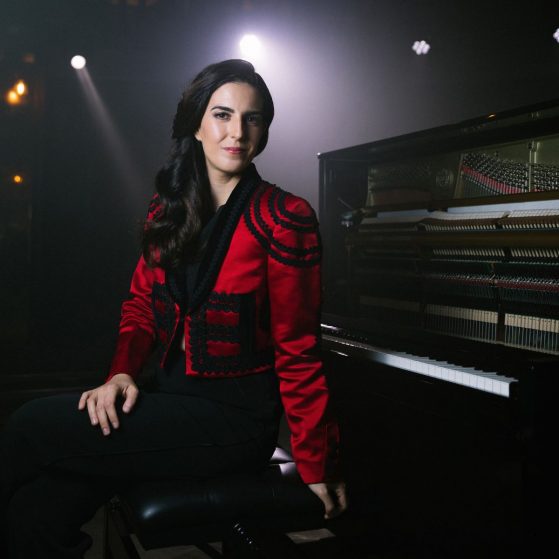Turkish pianist and composer AyseDeniz Gökçin has amassed hundreds of thousands of followers and tens of millions of streams for her fearless virtuosity, ingenuity, and winsome joy in music-making, from classical crossover covers of Pink Floyd and Nirvana, to reimagining’s of Bach and Beethoven.
In Spring 2023, AyseDeniz will release her third full studio album and her first with string orchestra, Patterns on Audio Network.
Classical Crossover Magazine (CCM): Can you tell us about your journey as a pianist and composer, from your early beginnings being what many would describe as a child prodigy?
AyseDeniz Gökçin: About two months before my mother was due to give birth to me, she went to see the movie “Amadeus.” As soon as the music started playing, I began kicking so vigorously that my mother thought she was going into labor. She left the theater, and once she was away from the music, I returned to my usual serene state, giving her a clue that I might become a musician someday.
Growing up in Türkiye, we had a Kawai upright piano, and I would spend hours each day playing and pretending on it. My parents would listen patiently to my imaginary performances as a singer and pianist, while my dad filmed those moments. Once my fingers were long enough, I started formal lessons when I was five and a half. At the age of six, I participated in the “National Child Prodigies Exceptional Talent Competition” organized by the Rotary Club, and to my surprise, I emerged as the winner in my own age category. As a reward, they presented me with a massive box of candy, a bicycle, and even life insurance. It was at that moment, when I saw the box of candy, that I declared to my parents that I wanted to become a pianist.
A year later, I was playing Chopin. I promised to myself that I would dedicate my life to music and would never put anything in between me and my piano. It was a serious commitment I made at a very young age! The rest is history – I gave my first concerto performance at 9. I got into Juilliard (but did not attend), moved to Spain for a while, and studied with the legendary Rosalyn Tureck who inspired Glenn Gould. It has been an interesting journey – always challenging, very often lonely, but amazing. I knew that all the effort would ultimately prove to be rewarding in the future so I worked really hard. I never had a holiday for longer than a week until I was 21.
CCM: How did your education at the Eastman School of Music and the Royal Academy of Music shape your musical style and approach to composition?
AyseDeniz Gökçin: Growing up, none of my friends played music professionally or even enjoyed classical music, and I struggled to relate to them a lot of the time. This changed when I went to college: Eastman was like Hogwarts – a magical place where everyone was like me. We would harmonize ringtones, knock on each other’s dorm room doors with rhythms from symphonies and ballets and try to guess the piece, and the cafeteria would be a party scene with percussionists playing on plates and cutlery. It was the first time I felt like I belonged and this changed the way I looked at music: it suddenly became fun to make music and share the joy with my friends. I still miss our sight reading parties and whistling in 4 parts with my friends in the hallway. To me, Eastman meant finding community.
The Royal Academy was where I fine-tuned both my technical skills as well as honed in on what I wanted to say musically. I was more ready as a performer and eager to dive into the real world with new projects. Also, getting out of Rochester where there were more limited cultural and professional resources, I was dedicated to embracing the seemingly unlimited arts and culture offerings London provided. I became a member of almost all operas/theatres and made use of their discounts for students. I went to 135 events the first year.

CCM: You are known for uniting classical and popular music. Can you talk about what inspired you to combine genres and how you approach the fusion?
AyseDeniz Gökçin: When I was growing up, adding beats to classical music became pretty trendy. Vanessa Mae and Maksim were doing this – and I wanted to do something totally different. How would it sound if Liszt had composed/transcribed Pink Floyd songs? I did this for fun and didn’t think people would enjoy them, but the arrangements went viral and even got mentioned on the official Pink Floyd Page. That started building a fanbase for me that I am so grateful for. Suddenly I had a platform to play the music I loved making and an audience who appreciated it. That was a major turning point in my life.
Non-classical music has always been a way for me to connect with people around me: my family, my classmates, and others. I loved listening to The Beatles, RHCP, Metallica, Eminem, Turkish Rock groups (Duman and Mor ve Otesi), Spice Girls, N’SYNC. There is so much amazing music from all genres that I didn’t want to limit my vision to one genre. Back then, incorporating more mainstream genres into classical concerts was less common, and a lot of purist musicians didn’t take me seriously, even though my audience was responding so positively. My aim is and always has been to unite audiences, and that means rethinking the constraints of genre.
CCM: Now about your upcoming album, Patterns. Could you give us some insight into the meaning behind the album’s title and the patterns you sought to create within the music?
AyseDeniz Gökçin: I am so proud of this album – and I never say this. I always dreamt of creating music for piano and strings and most of my CD collection as a kid was soundtracks. When someone would ask about what I wanted to accomplish, I would say “I want to win an Oscar for Best Soundtrack” which is a little crazy considering I was studying to be a classical pianist, rather than a composer.
Years later, I am releasing my original compositions recorded with 22 strings and it’s all inspired by film composers. The process of it has been incredible: I worked with so many people who supported me from start to finish. Audio Network who produced it has become a family to me.
The moment I heard my pieces come to life with a string orchestra, I almost cried. It was like giving birth and seeing the child for the first time. As a composer, I hope this album will be a stepping stone into writing more music for the screen and I cannot wait to see how it will be used or licensed. I also cannot wait to perform them live!

CCM: Your first track from Patterns, “Chaos,” features two pianos and a string orchestra. Could you describe your vision for this piece and what inspired its composition?
AyseDeniz Gökçin: I used a felt piano and a grand piano. I love the texture of the felt piano and it acts here as a way to start off softly and the grand piano takes over with stronger attitude and then lush melodies. In other tracks, however, I use the felt piano to add a layer of new melodies and effects to enhance the sound and create a magical environment. For example, “Lunapark” – it’s about the old theme park memories we have and the felt piano really brings that feeling of intimacy. “Sunshine City” is another one.
CCM: Help In Harmony is a wonderful initiative that you recently launched to benefit those affected by the recent earthquakes in Turkey and Syria. Could you tell us a bit more about the organization and how you plan to use your platform to help those in need?
AyseDeniz Gökçin: I initially created Help In Harmony with my friends to raise awareness for the devastating situation in my home country and to ask for help through the two mediums I know the most about: music, and audience engagement. We received many submissions that you can see on our website (helpinharmony.com), from musicians all around the world sharing their words in solidarity with the survivors. We are now in discussions with music therapists around the world to create a syllabus and materials for children and families affected, and to make this an online platform for psychosocial wellbeing and emotional recovery post-trauma.
CCM: As a rising star in the music industry, what advice would you give to aspiring musicians and composers looking to make their mark in the classical crossover genre?
Always be true to yourself on stage, don’t be afraid to break the rules, and work hard!
CCM: Lastly, with such a large following on social media platforms, how do you balance your online presence with your creative work, and what do you enjoy most about connecting with your fans in this way?
Honestly, I am still working on finding a balance. One day I will learn how to manage my time a little better! What I love most about connecting with fans via my platforms is that no matter how different our lives our, the common denominator is always music.







Love, love, love it! Do you sell the music for this. I especially love Velvet Piano which reduced me to tears – the passion in your playing is amazing! I would very much like to purchase the sheet music for that or even the whole album, but cannot find it anywhere despite many hours of searching the net. Do you sell this?
Many thanks
Suzanne MacLean